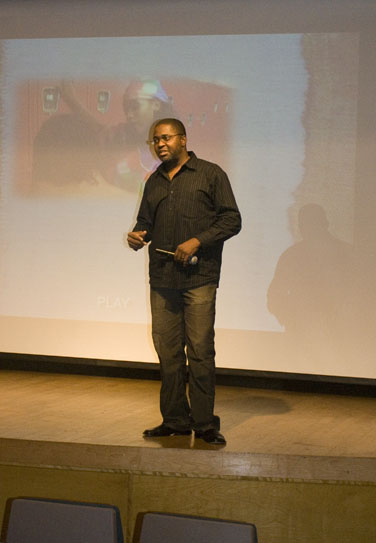A story of self-discovery and dance shown in ‘Sabar’

Director Chike Nwoffiah discusses Sabar, a film about a young girl and the dance she learns:
November 22, 2009
The journey of a young girl who finds a new form of dance and grows from it is the focus of “Sabar,” the latest film from documentary filmmaker Chike Nwoffiah.
A lecture from Nwoffiah followed the screening of “Sabar” on Wednesday, who used dance as a metaphor for love in his newest release.
“Sabar is a film that uses African dance as a backdrop and a metaphor for love,” Nwoffiah said. “The film is not a documentary about African dance.”
The film is about a young African-American girl who grew up dancing hip-hop and never cared much about the African dance or culture, but coincidently stumbles into a Sabar dance class. From there, her life starts to change as she discovers the African dance as well as herself and her new love.
Sabar is a colorful, energetic and celebratory dance that originates from Senegal, Africa, that almost defies gravity, Nwoffiah said.
The idea came from the United States rather than Africa, he said.
There are so many African dance classes across the major metropolitan areas from New York to Los Angeles, and what this movie does is it uses the movement of the dance and locates a love story within it, Nwoffiah said.
“It’s the first experience I’ve had with a film like this,” said Nicholas Meyer, an undeclared freshman. “It was very educational and interesting at the same time.”
People are not used to seeing African dance being shown on the big screen, he said.
“The movie was gorgeous the way the director directed it and did a great job portraying a young African-American dancer,” said Tyrus Ambrose, sophomore nursing major. “This film showed a lot of culture and diversity which is great.”
As an independent filmmaker, Nwoffiah put a lot of his own money into it. His colleagues, who were also part of the film, also contributed.
“Every frame that ended up there was supposed to end up there and I’m very happy with the outcome,” Nwoffiah said.
From the start of the filming to the first showing, it took Nwoffiah and his colleagues approximately three years to come complete the film, he said.
“I think the movie was great and they’ve done a good job with the presentation and actual deliberation of who the main character was trying to be,” said social work department staff member Patricia Holmes. “It would be nice to see more of what happens next.”
Blazej Bruzda can be reached at [email protected].























































































































